#Transcend Censorship
Explore tagged Tumblr posts
Text
Navigating the insurance and legal systems with a brain injury: Tips for self-represented plaintiffs
#Me: Please summarize this entire thread and start it out with a fun ROSES ARE RED, VIOLETS ARE BLUE intro poem #ChatGPT: Sure, here’s a summary of the thread in the form of a fun intro poem: Roses are red, violets are blue, Let me summarize this thread for you! A plaintiff with a brain injury, Hired a lawyer, but oh so miserably. The attorney cheated and lied, Leaving the plaintiff…

View On WordPress
#Brain Injury Self-Representation Litigation Intimidation Legal Assistance Justice System Disability Rights Insurance Claims Settlement Negot#IF YOU KNOW SOMETHING - POST SOMETHING#State Farm Broke Your House too?#tinyurl.com/WinWithoutLawyers#Transcend Censorship#Water Damage#WE ARE THE MEDIA NOW#When GreedGoverns#WIN WITHOUT LAWYERS
0 notes
Text
Queer Coding in Media: Jayce and Viktor's Case.
Let's address what Christian Linke recently said about Jayce and Viktor's relationship because this is making some noise in the community:
According to the co-creator, Jayce and Viktor love each other like “brothers”.
Christian states that he doesn't understand why people see their relationship as a romantic one.
Linke also added, after the end of the series, that Viktor is canonically asexual and dismissed a possible romantic relationship with Jayce due to that reason.
We'll expand on these points next. But first, some context.
| About queer coding...
If Jayce and Viktor's relationship is seen as beyond brotherly, it's because it was portrayed that way. Their relationship is very queer coded.
Queer coding refers to the practice of subtly implying that a character in a piece of media is part of the LGBTQ+ community without explicitly stating or confirming it. This is often achieved through subtext, symbolism or specific character traits associated with queerness. This often arises due to societal restrictions, censorship or creators intentionally embedding queer elements into their work.
Queer coding for a couple in media involves using subtle visual, narrative or dialogue-based cues to suggest a romantic or deeply intimate connection between two characters without explicitly confirming their relationship as romantic or LGBTQ+. This type of queer coding focuses on the dynamic between the two characters rather than just one individual's traits.
When discussing queer coding in media, the examples can include both the content of the relationship itself (dialogues, interactions and dynamics) and visual and non-visual narrative (cinematographic techniques, narrative techniques and the use of music). Both aspects—content and narrative—are essential to queer coding because: a) Content provides the material that audiences can latch onto (dialogues, dynamics or gestures) and b) the narrative guides how the audience perceives this material (through visuals or music, for example).
Below are examples and methods used to queer code couples:
Relationship's Content (character's dynamics and dialogues):
These are the in-universe moments or dialogues that give romantic or emotionally intense undertones to the relationship. For Jayce and Viktor, this includes:
1. Use of subtext in dialogue or relationships:
Ambiguous or "more-than-friendship" dynamics: Characters have intense emotional bonds or interactions that go beyond typical friendships but stop short of being explicitly romantic. Jayce and Viktor’s connection, for example, is filled with vulnerability, admiration and devotion beyond brotherhood. Their willingness to risk everything to save each other in each timeline adds a tragic, almost romantic layer to their bond. Jayce’s comment calling Viktor “beautiful despite his imperfections” and their mutual sacrifices suggest a deep connection that goes beyond friendship or platonic relationships. Their bond, tied to time loops and destiny, feels more like a soul bond with a cosmic significance that transcends a typical brotherly dynamic. In other cases, this would be a romance.

Loaded Dialogue: Lines of dialogue may carry double meanings or suggest emotional or physical intimacy without being overt (e.g., characters use ambiguous terms like partner, special or soulmate, which can suggest deeper feelings without explicitly labeling the relationship). For example, if one says, "I��d sacrifice everything for you," it resonates beyond platonic territory. Dialogue between Viktor and Jayce is filled with layered meanings that suggest a connection deeper than traditional friendship. Here are some examples:
When Viktor’s former mentor warns him about sacrificing love and legacy, Viktor instinctively replies "Jayce will understand," directly associating Jayce with love and signaling how central Jayce is to his emotional world. Similarly, Jayce’s decision to abandon politics to return to the lab is encapsulated in the line "my place was always here in the lab with you," which emphasizes that his devotion isn't just to their work but specifically to Viktor. The repeated use of "partner" by Jayce further blurs the lines between professional collaboration and emotional intimacy, as the word carries dual meanings, suggesting equality and closeness. The term is somewhere between friends, brothers and more than that. Hence, the term can be freely interpreted. Viktor later reflects on their bond by stating, "it was affection that held us together," acknowledging that their relationship transcended shared goals and was rooted in genuine emotional warmth. Finally, Jayce telling Viktor, "there is beauty in imperfections," as he admires Viktor’s struggles and physical challenges, conveys profound validation and care, elevating their bond to one of deep emotional resonance. These lines collectively demonstrate how their dialogue is charged with a sense of intimacy and mutual admiration, allowing the relationship to be interpreted as more than platonic, hinting at queer coding through its emotional depth and layered expressions.
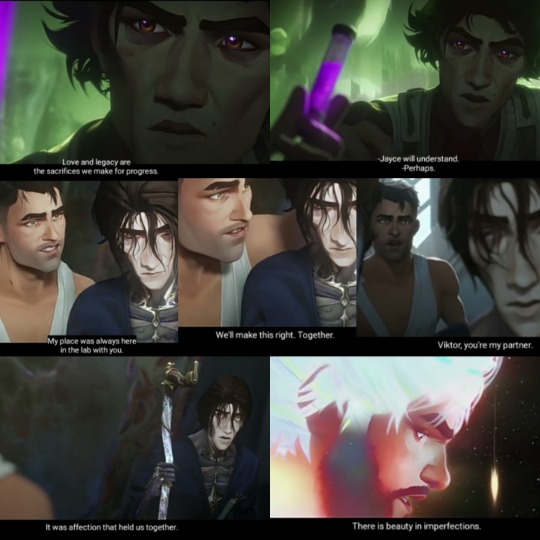
2. Body language and interactions:
Lingering gazes or physical proximity: Close, lingering touches, extended eye contact or standing too close for “just friends” —common romantic cues—are often used. For example, long hugs, holding hands or standing closely during emotional moments are subtle ways of suggesting attraction or intimacy. In Jayce and Viktor's case, Jayce is almost always the one who initiates the physical contact. Jayce's non-verbal language with Viktor is marked by gestures of reassurence with a hand on his shoulder, hugs without centimeters of distance and fast moves to help Viktor in the face of his weakening due to his illness. An important detail to take into account is Jayce's reaction to Viktor and Mel's return. When Viktor returns from the dead, Jayce surprises his friend with a hug that knocks him off balance by his strength. When Mel returns after no one knew of her whereabouts, Jayce doesn't even hug her, but instead complains about why she didn't save Viktor.
Protective gestures: Scenes of one character sacrificing for, protecting or expressing deep vulnerability to another can suggest more intimate feelings. Jayce and Viktor's relationship also has the presence of hundreds of moments in which they both profess for the safety and well-being of the other. In season one, after having sex with Mel, she wakes up in an empty bed. It turns out that Jayce was with Viktor, waiting on the side of the bed for him to wake up. This detail alone shows where Jayce's loyalty lies. But, overall, Jayce is very delicate and helpful towards Viktor. In turn, the only moment in which Viktor initiates physical contact is to reassure Jayce so that he doesn't feel pain on the astral plane. Both join their foreheads in a significant gesture of appreciation and affection and console each other at the end of their existences.
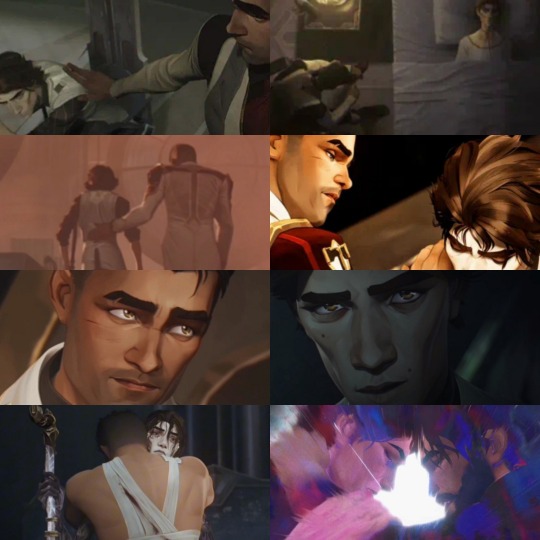
3. Avoidance of heteronormativity:
Lack of romantic interest in the opposite sex: A queer-coded character may show no explicit attraction to the opposite sex while forming deep emotional bonds with same-sex characters. This is especially true for Viktor, who has had no interest in any character of the opposite gender during the two seasons. The guilt Viktor felt over Sky's death shouldn't be confused with sexual, romantic or aesthetic attraction. Viktor practically didn't even know Sky's name during the first season and, despite knowing each other since childhood, Viktor continues to call her "Miss Young" during the second season. As you may already know, Sky's presence in the second part of Arcane represents what Viktor has left of humanity. Jayce is a separate case, since he did have a sexual-affective relationship with Mel, despite not being officially a couple. However, he always put Viktor's well-being above his relationship with Mel.
Unconventional partnerships: Instead of marrying, having children, or living “normal” lives, queer-coded characters often follow nontraditional paths. The unconventional partnership between Jayce and Viktor lies in their shared path of devoting their lives to science and progress instead of following more traditional societal expectations. Their bond, rooted in their shared ambition and mutual understanding, creates a life partnership that revolves around innovation, discovery and reshaping the world. Together, they prioritize their intellectual and creative pursuits over conventional relationships, with their lab becoming the core of their connection and purpose. This can be seen, for example, in the moment when Jayce decides to resign from politics because he realizes that his place is next to Viktor in the lab. This partnership not only defines their lives but also strengthens their relationship, making it deeply meaningful and unique in its intimacy and shared vision.
Visual and non-visual narrative (cinematographic techniques, narrative techniques and music):
These are the deliberate storytelling choices that imply deeper subtext or allow the audience to interpret a couple's bond as queer. Examples include:
1. Visual narrative:
Symbolism (in scenes): are visual and narrative moments intentionally designed to evoke ambiguity, emotional depth or hidden meanings in a relationship. These scenes often rely on subtext, metaphor or visual framing to suggest intimacy or connection between two characters, leaving their nature open to interpretation. For example, Jayce's campfire scene. Fire might symbolize Jayce's internal turmoil. Mel appearing first may reflect her role as a significant figure in Jayce's life, while Viktor appearing next could symbolize a deeper, enduring connection. The fire "burning away" Mel and transitioning to Viktor might suggest that, in this moment, Jayce's thoughts are consumed by Viktor, representing a priority or emotional focus shifting toward Viktor. So, Viktor isn't simply a colleague or friend but someone whose presence looms large in Jayce's thoughts, surpassing Mel's. While the scene might not explicitly state anything romantic, the visual choices align with tropes often used to convey profound emotional connections, making it easy to interpret the subtext as romantic or deeply personal.
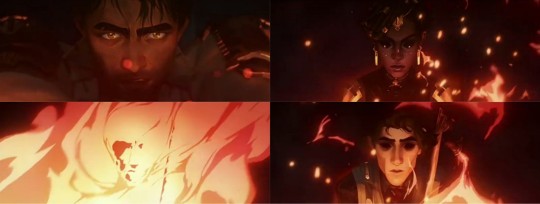
The decision to interweave Viktor’s scene with Jayce and Mel's scene while having sex is highly unusual too. If Jayce and Viktor are purely platonic friends, such a juxtaposition does feel strange. I understand, both Jayce and Viktor are "merging" with something beyond themselves, but can you imagine a similar scene with Jinx and Vi? If Jayce and Viktor's relationship were purely professional, friendly or brotherly, such imagery wouldn't normally feel warranted in storytelling.
Parallelism: In storytelling, parallelism refers to the use of comparable or mirrored elements—such as characters, themes or visuals—to draw connections or contrasts. It often involves showing two or more situations, characters or relationships side-by-side to highlight their similarities, differences or shared significance within the narrative. In Arcane, the creators align Viktor with Mel through parallels. Through this technique, creators seem to suggest that Viktor holds a similar or even equivalent place in Jayce’s life. Since Mel’s relationship with Jayce is explicitly romantic, this framing subtly implies that Viktor could also occupy a romantic or emotionally intimate role.
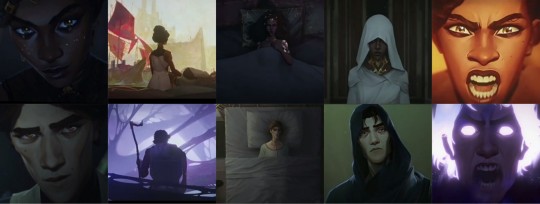
2. Non-visual narrative:
Music and Lyrics: are powerful tools to subtly hint at romantic or emotional dynamics between characters without explicitly stating them. By selecting specific songs or using lyrics that carry layered meanings, creators can invoke emotions or associations that resonate with queer themes, intimacy or romantic undertones. Songs that have lyrics with open-ended or ambiguous lines, when placed over scenes with queer-coded characters, allow for multiple interpretations. This creates a sense of queerness without labeling it outright, allowing the audience to interpret the relationship as they see fit. As is the case of the song The Line by Twenty One Pilots. Through the line "pull the blanket tight now" you can interpret the song from Viktor's point of view and dedicated to Jayce (since Jayce was the one who gave the blanket to Viktor).
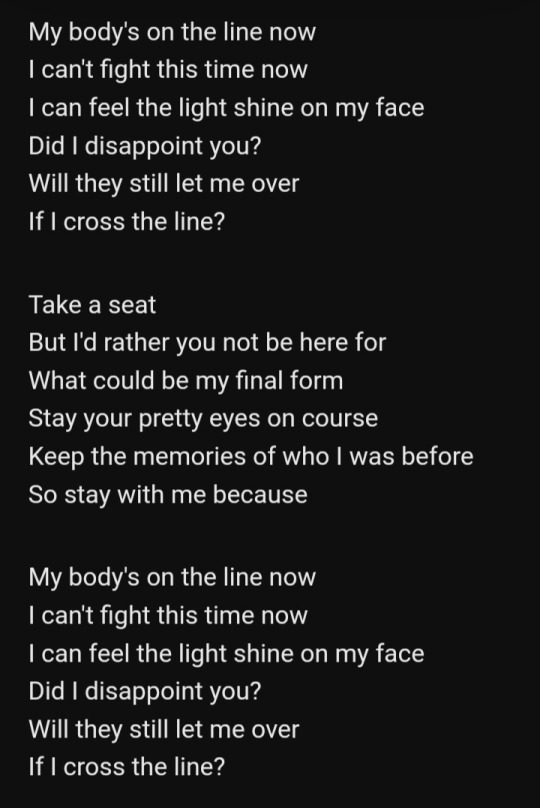
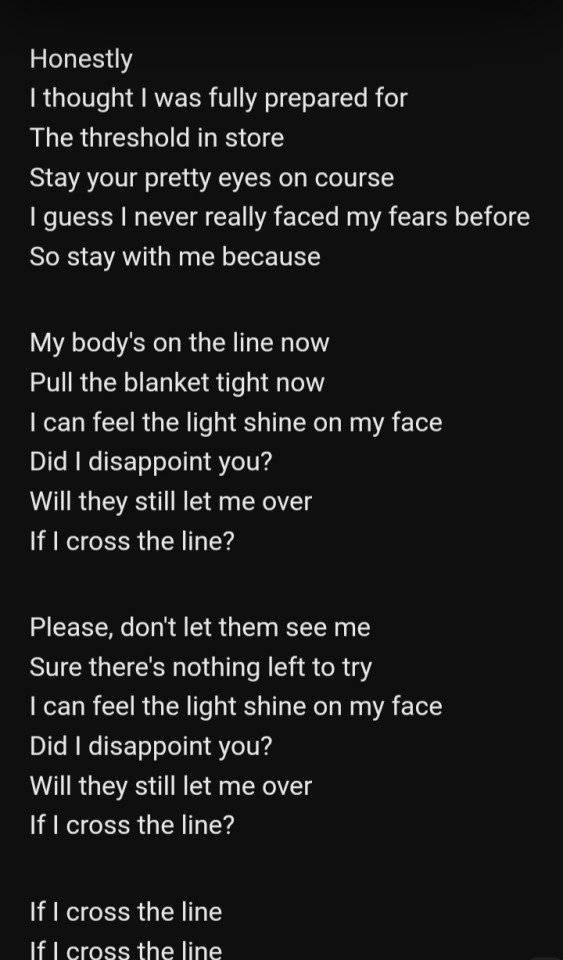
Comparisons and mirroring: narrative parallels with romantic couples, either in character arcs, sacrifices or framing. For example, Jayce and Viktor share a significant bond across multiple timelines. Jinx and Ekko, meanwhile, also share a significant bond in another timeline. This could be interpreted as both couples choosing each other, even, in alternate universes. This is an idea that is commonly related to romantic relationships. Love across different universes is seen as something beyond fraternal and worthy of epic romantic love. In the same episode that Ekko meets Jinx in another timeline, Jayce meets Viktor in another timeline too. The same thing happens in episode three of season two. In the same episode where Vi and Caitlyn fight and part ways, Jayce and Viktor also fight and part ways. In this way, Jayce and Viktor follow a similar pattern and theme (albeit on a larger scale) to that of the other canonically romantic couples in the series.
Subtext in dialogue: refers to lines with double meanings that subtly suggest emotional or romantic undertones. The choice by the creators of lines that are commonly associated with romantic relationships such as "beautiful despite the imperfections", "in all timelines, in all possibilities, only you can show me this", "my place is in the laboratory, with you" or "it was affection that held us" convey an ambiguous message that leaves the possibility of multiple interpretations open. The use of the term "partner" was not accidental either. This word is commonly used by queer individuals to signify a romantic relationship while avoiding gendered language. Jayce and Viktor not calling each other “brothers” is significant because it leaves room for ambiguity, suggesting that the creators might not have wanted to firmly define the relationship. Jayce only called Viktor "brother" once and then insisted on the term "partners" until the end of the series.
As you noted, these aren’t accidental choices—they are purposeful creative decisions made by team members who do support the romantic interpretation of Jayce and Viktor's relationship. Animators, voice actors and designers contributed to shaping this relationship through subtle creative choices. For example, animators might have chosen specific expressions or gestures to convey deeper intimacy, even if this wasn’t explicitly stated in the script. Leaving their relationship ambiguous might have been seen as a “safe” route in the face of disagreements.
In collaborative works like Arcane, no single individual (not even Christian Linke) dictates the entirety of what's canon or not. Creative contributions from diverse team members with their own agenda and interpretations also shape meaning.
If the intention was to show a “brotherly” relationship but the execution led to widespread interpretation of a romantic one, it's failure in storytelling. If the intention was to show a "queer coded" relationship and the execution led to widespread interpretation of a romantic one, then it's success in storytelling.
Death of the author: Viewers also have their own interpretations and that's valid. Varied interpretations shouldn't be dismissed. Here the death of the author applies. This term refers to the fact that, after an author publishes a piece of work, that piece ceases to belong exclusively to the author. Once a work is released, it belongs to the audience as much as the creators. If significant parts of the fanbase interpret Viktor and Jayce as more than friends, that interpretation becomes part of the narrative’s cultural impact, regardless of authorial intent.
The interpretation in media of queer codes is deeply influenced by cultural cues. Although this changes from society to society, social cues are the same for everyone. If Viktor and Jayce’s interactions evoke a sense of romance, it’s because the storytelling taps into those cues, whether intentionally or not. The relationship between them two integrates cultural and social codes typical of queer relationships.
Cultural codes: are tied to traditions, beliefs and shared understandings within a specific culture or subculture. They include symbols (objects, gestures, or imagery that carry specific meanings within a culture —e.g., a wedding ring symbolizing commitment—), narrative patterns (storytelling conventions that audiences recognize, such as the "star-crossed lovers" trope or visual parallels that suggest a connection between characters), expressions and language (words, phrases, or metaphors that carry connotations shaped by cultural usage —e.g., the word "partner" often implying romance in contemporary Western culture—.
Social codes: are the behaviors and norms that define interactions and relationships between individuals or groups. These codes are often context-dependent and include: body language (physical gestures or proximity that suggest intimacy, power, or affection —e.g., lingering touches or intense eye contact indicating closeness—), relationship norms (expectations about how certain types of relationships—platonic, familial, romantic—are expressed in actions and language) and contextual cues (the way relationships are framed by their environment, such as a candlelit dinner indicating romance or playful banter suggesting friendship).
The way Viktor and Jayce interact is coded in a way that aligns more with romantic love than familial or platonic love. So, asking to associate Jayce and Viktor's relationship with a “brothers” type of relationship would mean having to disregard cultural and social codes.
| Romantic Undertones as "Canon Adjacent”.
As I previously said, the romantic undertone of Jayce and Viktor's relationship would result in a canonically established couple in any other series. So, what I see here is a double standard in romantic representation in the series. For example, many think that Ekko and Jinx are canon after (a conversation that wasn't added to the series and after...) Ekko gave his jacket to Jinx. Jayce and Viktor’s dynamic features more romantic subtext than that but they still are dismissed as "brothers". Is this homophobia? No, of course not. How could it be homophobia if Arcane shows an established lesbian couple? Well, let me tell you, lesbian representation is more socially accepted in male-dominated spaces due to fetishization, whereas romantic relationships between men are less embraced. The idea of two men in love can lead many people to question the masculinity of these men and the masculinity associated with characters like Jayce or Viktor is vital to League of Legends. Making a canonically gay male character is riskier for the franchise because, in lol, masculinity is an element that, many times, determines the election of one character over the other.
Unlike Vi and Cait, among whom (I understand) there was the belief of a romantic relationship, Jayce and Viktor were never associated in that way. So, I can see the risk.
If Linke intended to focus on male friendship, that’s fine, but dismissing other interpretations, especially in a story as emotionally charged as Jayce and Viktor’s, can come across as limiting or dismissive of queer readings, whether intentional or not. It would have been better for Christian Linke to shut up and let everyone have their own interpretation about Jayce and Viktor's bond. Instead of insisting on interpreting Jayce and Viktor’s bond as “brotherly”, it would be more inclusive and respectful to let viewers interpret their relationship freely. By insisting on framing Viktor and Jayce as just “brothers” or “friends,” the show risks falling into the “no-homo” trope, where creators deliberately steer clear of portraying characters as gay despite clear romantic subtext.
| Linke's arguments.
Arguments like "media lacks non-romantic platonic relationships" feel insincere because these type of relationships aren't underrepresented in media. That crisis never existed. Many popular shows and movies focus on deep, platonic male bonds (e.g., Sherlock Holmes, The Lord of the Rings, Supernatural). While it’s admirable to showcase strong male friendships, it’s not a groundbreaking theme. In such a case, there is a lack of representation of non-romantic platonic relationships between men and women. These type of relationships are equally rare and more deserving of advocacy, but we still have timebomb (Jinx and Ekko). In conclusion, media has no shortage of non-romantic male-male bonds, but LGBTQ+ male romantic relationships remain underrepresented. So, Christian Linke's dismissal about JayVik was even more noticeable after that argument.
Also, I would like to add that referring to a relationship as a "romantic" one doesn't diminish the importance or depth of a bond. Friendship isn’t erased by romance. In fact, many memorable romantic relationships in media are related to friendship (e.g., Anne and Gilbert from Anne with an E). But, to call it a brothers-like relationship would diminish the profound, cosmic depth of their connection because their bond is about recognition, unconditional support and shared purpose, even at the cost of the world. It’s poetic and tragic, resonating with themes of love, identity, and the human condition. The time loops, their repeated choice to find each other and their interconnected destinies make their relationship feel larger-than-life. For many viewers, this mythic quality resembles soulmate narratives rather than simple friendship or brotherhood.
Another argument that reveals Christian Linke's rejection of Jayce and Viktor as a possible romantic relationship, is the statement about Viktor being asexual. I would like to ask what is the point of revealing this information after the show ended? Representation works best when it's woven into the narrative, not dropped as an afterthought. Beyond that, I think Mr. Linke should educate himself. Experiencing little or no sexual attraction doesn't mean that romantic attraction cannot be experienced. Being asexual doesn't mean that a person can't be gay.
Asexuality: is a sexual orientation characterized by the lack of sexual attraction to others. This means that an asexual person typically doesn't experience the desire to engage in sexual activities with anyone, regardless of gender. However, asexuality exists on a spectrum. Asexuality as a spectrum refers to the understanding that asexuality encompasses a wide range of experiences and expressions of little to no sexual attraction. Rather than being a single, fixed identity, the asexual spectrum includes various orientations and preferences regarding sexual and romantic attraction.
Many asexual people form deep, meaningful romantic bonds and there's no inherent contradiction between being asexual and experiencing romantic feelings. To use Viktor’s supposed asexuality as a reason to dismiss any potential romantic undertones between him and Jayce feels reductive and dismissive—not just of their dynamic, but also of the diverse experiences of asexual individuals.
Let's end this post on a more positive note with Arcane team members who do support Jayvik.
Posts from animators + Jayce's voice actor with a JayVik fanart.
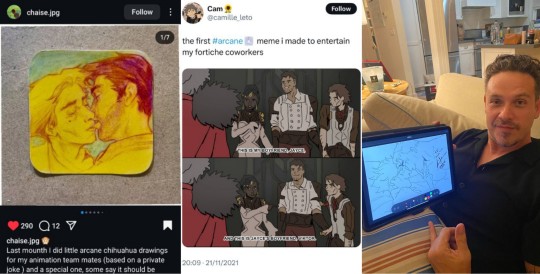
Viktor's character designer + posts from animator.
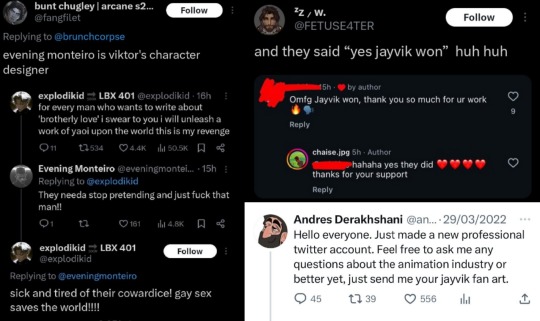
Moose is the creative director + AgentR is an animator + Mel's voice actress.
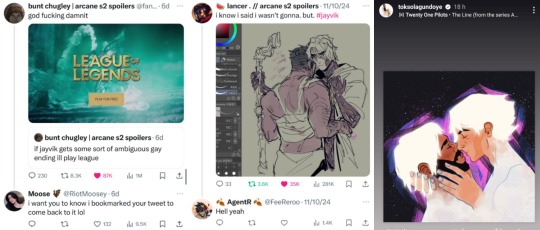
#jayvik#jayce#jayce talis#jayce arcane#arcane jayce#jayce lol#jayce league of legends#viktor arcane#viktor#viktor league of legends#viktor lol#jayce x viktor#viktor x jayce#viktor and jayce#jayce and viktor#mel#mel arcane#mel medarda#lgbtq#lgbtqia#arcane#arcane season 2#arcane 2#arcane spoilers#arcane s2#shipping#otp#arcane meta#arcane analysis#meta
777 notes
·
View notes
Text
on the wwdits ending and queerbaiting:
a lot of yall didn't live through the 90s and 2000s when off camera non-sexual not-shown-only-implied queer relationships in media were all we got. we held onto every last crumb and watched the creators deny any gay intent (because of network censorship etc.) and we just accepted it.
I do NOT want to go back to that. WWDITS brought us back to that.
the creators intentionally hit every textbook romantic beat with nandermo and teased it for years and then turned around and essentially said the fans were sick perverts for wanting them to kiss on screen when they literally showed lazlo giving bodyswapped nadja doll/colin robinson who lazlo was a father figure for backshots but noooo nandermo is too kinky because it's his boss??
don't act like it's out of character because nandor is shown to be forward with his affections towards women and sexual with men, and has spent his whole character arc searching for a wife. guillermo has spent his whole character arc coming back to his love for nandor again and again in new ways.
yes their love is pure and transcendent and whatever but showing them kiss or fuck doesn't sully that!! it deepens and confirms it!! sex is not impure!!
yes nandermo is canon, it's confirmed in the finale in the implications and stolen glances. but that is NOT ENOUGH for me. it's a cop-out.
saying "these two are kissing but only when the cameras are off" does a disservice to gay fans who remember the time when that's all we had.
if you're going to market your media as queer you have to ACTUALLY SHOW THE QUEERNESS ON SCREEN.
#wwdits#wwdits finale#wwdits s6#what we do in the shadows#nandermo#guillermo de la cruz#nandor the relentless#nandor x guillermo#mine
670 notes
·
View notes
Text
This scene lives rent free in my head. The juxtaposition of Lingling being absolutely adorable, living his best life


Meanwhile, Ruan Nanzhu: 40k slow burn, brooding, major pining hours, starcrossed lovers, doomed by the narrative









Meanwhile, my brain short-circuited during this scene. I was convinced they would kiss, a scene transcending Chinese censorship
#spirealm#the spirealm#kaleidoscope of death#ruan nanzhu#ling jiushi#for a minute immersion was complete and I forgot I was watching a chinese bl#ruan nanzhu flirting with everything known to man#meanwhile lingling: how's my cat doing?#I can never be normal about this scene
85 notes
·
View notes
Text
[4.0]: A Theory On Rhinedottir, Alchemy, and the Meaning of Sin
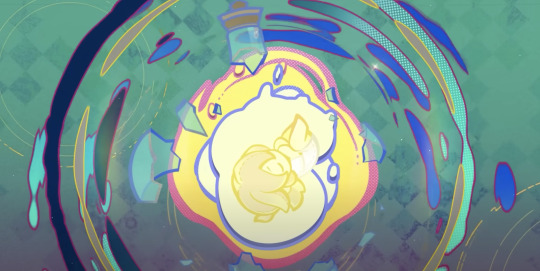
“One thought may end all calamity, and there will always be thoughts that may transcend time.” -The Meaning of Aeons “Separate the dust in the flames with joy, and extract the exquisite from the crude. For all in the universe comes from a single source, and all things may be derived from a single thought.” -Cinnabar Spindle
I’ve been wanting to do some Rhinedottir speculations for a while. With the new Ancient Colors world quest in Fontaine, I think now is a good time to propose a theory about this mysterious member of the Hexenzirkel, her approach to alchemy, and the reason she is a “sinner,” especially within the context of one of the Archon Quest’s central questions: what does it mean to be “born with sin”?
SPOILERS: Up to Act II of the Fontaine AQ (just Primordial Sea stuff), and Ancient Colors.
Although Rhinedottir is never mentioned by name in Ancient Colors, all of the signs of her are there: Mamere’s identity as an artist, Elynas’ otherworldliness and similarities to Durin, and the differences between the Melusine’s perception of the world and our perception of it (or their aesthetics, which we will touch on later). Ancient Colors is trying to remind us of Dragonspine and, if you were playing during this time, Shadows Amidst Snowstorms, and I believe it is doing so because it is key to the secret of the Primordial Sea and the prophecy of Fontaine.
We’ve heard Rhinedottir’s perspective only twice so far, and that was in the Windblume festival from this last year and in Cinnabar Spindle’s lore. Though we still don’t know much about her, she does identify herself as a “mother” of many children, and that she is raising the only son she has left. This, of course, is Albedo.
We also know that she is considered a "sinner" at the center of the Cataclysm who unleashed "an army of shadowy monsters" onto Teyvat, but we have very little grasp of what exactly is meant by "sinner," and what if any consequences this label has had on her since then. Although every Hexenzirkel witch will undoubtedly be very important to uncovering the truth of Teyvat, Rhinedottir presents a particularly interesting case as the only one whose activities may have caused cataclysmic destruction, as opposed to Alice's general mischief and strange sense of humor.
It’s almost nothing to go off of, but I hope to demonstrate in this speculative theory that it’s more than enough to arrive at some answers.
Psychoanalysis 101, Round 2
To better explain what Durin, Elynas, and Rhinedottir’s other children are, we need to use an analogy rooted in Freud’s psychoanalytic theory of dream interpretation. This is a super TL;DR version of it and way oversimplified, but if you’re interested I wrote a more detailed theory about the significance of dreams in Genshin that has a full explanation of it there. (Also, it should be said that these were just Freud’s theories, please do not take any of the following as an accurate description of the human psyche and how it works. We are just having some fun for the sake of media analysis.)
Freud thought that dreams are the mind’s means of expressing unfulfilled wishes, and that the psychological purpose of dreaming is to “fulfill” those wishes. In A General Introduction to Psychoanalysis, he gives an example of this through a little girl’s dream where she was sailing on a lake: this dream was born out of an unfulfilled wish in her waking life, where she had to stop sailing on the lake despite wishing to continue. Hence, “I wish to sail on the lake” becomes “I am sailing on the lake” through the dream.
Further, Freud thought these unfulfilled wishes are “forgotten” in our unconscious mind when we are awake, censored by the ego to protect our conscious mind, but that at night this censorship is weakened. This is what allows a dream to occur while we sleep.
These unfulfilled wishes are often more complicated than a childish wish to keep sailing on a lake. Think about it this way: a wish is, at its core, a thought in our head, or a desire. What do we do with the thoughts we don’t like, the ones that are unbecoming of us or are unacceptable to fulfill?
We deny them.
Specifically, we repress them into the unconscious, where they are forgotten. Thing is, even if we temporarily forget these thoughts, they won’t just disappear from existence - they fester in the unconscious, waiting to be expressed. The dream, therefore, is the unfulfilled wish/repressed thought’s attempt to cross the boundary from the unconscious mind into the conscious mind - to be acknowledged, or indeed remembered.
“Unfulfilled Wishes”
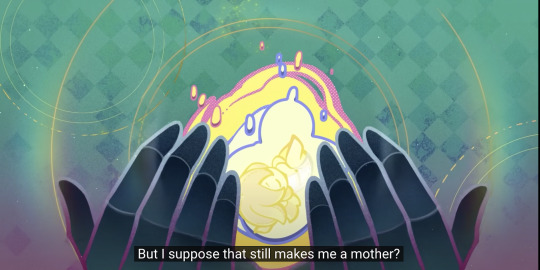
Making sense so far? If so, try to think of Teyvat like this: everything that is visible, everything above ground that the light touches and that can be perceived is like the ego and conscious mind. All of these things are what you’re aware of, things that you “know” and can make sense of, things that you understand, things that fit into rules and laws and order.
Now, think of everything in Genshin that is “unseen” and “unknown”: the Abyss, the spaces underground, forbidden knowledge, things that are “not from this world,” from beyond the firmament…these are like things from the unconscious mind, the repressed thoughts that we deny in ourselves because they may reveal a truth we are unwilling to face. These things are comparatively chaotic in nature, things we’d rather avoid, or things that we wish to forget.
We know that Elynas’ and Durin’s bodies are composed of matter that’s foreign to Teyvat, and that this is a major reason why they are incompatible with Teyvat and cause its destruction. This would make them more similar to a repressed thought, something that we don’t understand or know, and attempting to understand it destabilizes our sense of self, our “truth.” It follows that their home, the Abyss, is most similar to our unconscious mind, and Teyvat is most similar to our conscious mind.

Elynas: Before I was born, I floated in the cosmic darkness. It was cold there, and lonely. I was so sad, then, and I would often cry.
So, as their mother, who or what is Rhinedottir in this analogy? Well, we can be a lot more specific than calling her a “sinner.” In fact, she’s a dreamer, and alchemy is the medium through which she “dreams”:
This was a story from long ago... Unborn life, unfulfilled wishes, Tragic dreams at the edge of the universal darkness that could never come true, Indwell my body, and descend unto this world. Then, my lovely children, Like rainwater flowing into creeks, and plants growing towards the sun, Go unto a lovely place, and display your own beauty there with pride. This is a memory, a memory that a child named Durin had of his mother… "Thank you, Mother, thank you." "You gave me wings to soar and a mighty form." "Mother, I wish to go to a land of lovely songs," "I will tell them about you, Mother, and about everyone else." "I shall tell them that the place where I was born is beautiful." -Festering Desire
Rhinedottir’s children, then, are like thoughts or ideas that she is bringing to life, or “making conscious,” by moving them from the Abyss to Teyvat. It may even be the reason why the sword from The Chalk Prince and the Dragon is called Festering Desire in the first place - it’s a reference to the idea of repressed thoughts, wishes, and desires festering in the unconscious.
Should the analogy hold true, it provides some insight into what her intentions may have been in creating her Abyssal dragons. But before that, we need to take a little detour into Enkanomiya and brush up on some lore.
Denouement of Sin
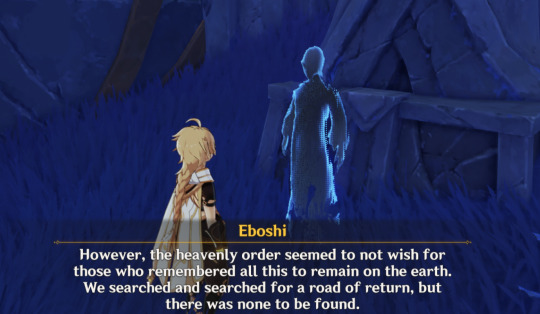
Eboshi: However, the heavenly order seemed to not wish for those who remembered all this to remain on the earth. We searched and searched for a road of return, but there was none to be found.
Remember these hologram-looking dudes? They are the Shades of Tokoyo, also known as Sinshades. They are described as afterimages of the former citizens of Byakuyakoku preserved by Istaroth’s favor, specifically those citizens’ most powerful emotions, and they are only visible during Evernight:
Eboshi: Due to the phenomenon known as Sinshades, the “past,” “history,” and “truth” of Enkanomiya would endure even if left to their own devices. Eboshi: As such, great effort was expended, not that we might remember, but that we might “forget.” Lady Sangonomiya was of this view.
Like a dream, Sinshades only appear at night, and they are a kind of embodiment of history or “truth” that Watatsumi Island has chosen to forget, representing the thoughts and emotions of those who once lived in Enkanomiya. Using Freud’s theory of dream interpretation as a framework, Enkanomiya then functions as Watatsumi Island’s unconscious mind.
Put another way, if all Sinshades are the result of strong emotions preserved in time through Istaroth’s favor, then those emotions are like thoughts, and that would make the Sinshade a “physical” form or expression of those thoughts. So, when we call the afterimages the “Sins of Tokoyo,” we are in effect calling them the “Dreams of Tokoyo,” because they are the thoughts and emotions of Enkanomiya given form, and that’s what dreams do: they convey thoughts and feelings through a series of images.
Through the Sinshades, we see an implicit association with the concepts of dreaming and sinning in Genshin’s worldbuilding, and through them we understand that they are not so different from one another.
A Brief Note on Aesthetics
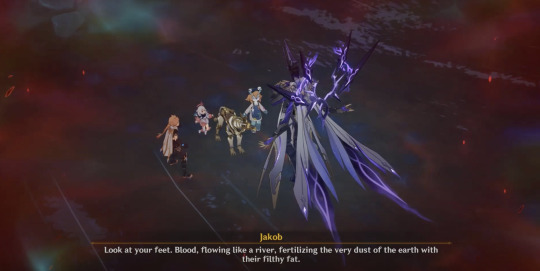
Jakob: Look at your feet. Blood, flowing like a river, fertilizing the very dust of the earth with their filthy fat.
It may have struck you how various Melusine perceive reality in a way that greatly differs from the things we see, as if at times their perception was “flipped,” if not somewhat strange. By the end of Ancient Colors, it’s clear that this is due to the Melusine being born of Elynas, who is not from this world. A similar phenomenon can be seen in both Durin and Elynas, the former imagining itself dancing with the people of Mondstadt before it “woke up” from this dream to Dvalin’s fangs in its neck, and the latter realizing that the things that it finds fun are destructive and harmful to the people of this world.
This is a part of the commentary present in several world quests and commissions in Fontaine that deal with “aesthetics,” or one’s own sense of beauty. Aesthetics are principles that differ on both large and small social scales, varying between groups of people and between individuals (see Salsa’s and Ubu’s aesthetic disagreement), and they can change throughout time as values change. In other words, they are informed by perspectives.
For example, think of what we know so far about the Primordial Sea. Neuvillette wonders how the Primordial Sea could be capable of giving life and then “suddenly reversing itself” so that it instead “devours life,” but this is just his judgment of what the sea does, and ultimately his perspective. Many others view the properties of the Primordial Sea differently from him: to them, the prophecy is comforting because it signals a “return,” or a “homecoming.” To take it a step further, Neuvillette may be making an assumption by stating that the sea has reversed itself. Perhaps this is just how the sea is, perhaps this is its “truth.”

Verenata: The "truth" will not be limited or constrained by the eyes and perspectives of the viewer, and won't be distorted by what is in their heart. It objectively exists, and it just is...like the white sand, like the bones of seastars, like the waves that crash and pound...those are "truth."
Now, imagine that you are staring at a 3D object from a 90 degree angle. If I ask you to describe the object from where you're standing, you'll be able to accurately tell me about what roughly half of the object looks like, but you won't be able to accurately describe the other half of it without help from someone standing on the other side of the object.
But how can you be sure there even is another side of the object, or that it's any different from the one you see now? From your perspective, what is already visible to you may seem sufficient to describe the object in its entirety. In other words, your perspective becomes your "truth."
It is only through considering additional perspectives that we broaden our own understanding of reality and expand on our "truth." However, broadening our perspective is usually not a comfortable experience, as is typical when we engage with ideas that differ from our own. Part of expanding our "truth" requires us to shatter our current understanding, pick up the pieces, and reassemble them into a shape that makes space for these other ideas and their "truth."
For example, when we confront Jakob at Elynas' heart, he describes the rushing currents beneath our feet as Elynas' blood. To the player, who has been swimming around in that for a couple of hours by that point, this idea is macabre and horrifying. However, when we consider Jakob’s perspective, his “truth,” it also expands our understanding of Elynas as a being that is somewhere between dead and alive, sleeping if you will, and that he is more than capable of waking up from his slumber with the appropriate stimulus. Another example is Canotila, who saw the wasteland in Rene's Book of Esoteric Revelations as a peaceful forest. When we consider Canotila's "truth," her aesthetic sense doesn't change the way we see the wasteland, but it does show us something equally important: the way that we experience the wasteland is not the only way it can be experienced.
If we return to the other ever-present metaphor of alchemy as a form of painting, we can see that Rhinedottir’s aesthetic sense greatly differs from what is acceptable and compatible with Teyvat. But, just like Mamere, she paints regardless of whether her paintings are understood by a greater audience. In time, Teyvat's "aesthetics" may change again, and perhaps her "art" will be received differently when that time comes.
Concluding Thoughts

(A pool full of Water from the Primordial Sea. Countless sins were born of it…)
So, that is why I think Rhinedottir was deemed a sinner. She sinned by “dreaming” up these chaotic life forms that were not from this world, bringing them into being through the Art of Khemia, and telling those chaotic life forms that they were beautiful, too, that the ordered and lawful world of Teyvat just needed to realize how beautiful they were. Maybe Rhinedottir was dreaming of a new world, one where her children’s wishes could be fulfilled, where they could exist with everyone, and maybe creating that world required the destruction of this one. You could also think of her as someone who has introduced “external variables” into Teyvat, which, hmmm..:
“...No matter how many times I derive it, the result remains the same, though this result is not expected... Unlike the world depicted in these ancient texts, there will be no more new civilizations born... Unless we consider introducing "variables" from outside the system... If it was that sort of power, there might be a chance…” -Enigmatic Page I, Book of Esoteric Revelations
In this way, her “children” (thoughts) were all “born with sin,” or are born from sin (dreams). If Rhinedottir is a dreamer, then alchemy is the way that she dreams: it allows her to give forms to these thoughts. And if you buy that, then there are some serious implications to consider from this whole notion of Fontainians being “born with sin,” and just what exactly the Primordial Sea might be. Definitely something to think about while we wait for 4.1.
One last point that is more of an aside than anything else: Rhinedottir’s only remaining child is Albedo, but through this lens we see that he is not just the culmination of the Primordial Human Project, the creation of a human through the power of alchemy, but also the only known example of Rhinedottir’s “ideas” that coexists with Teyvat as it is now. As for her known extant grandchildren, they have integrated with Fontainian society and don’t seem to cause them any trouble. I wonder if she knew something like that could happen?
But…that’s just my take on it so far. What do you think?
(also, fun fact: there is a parallel storyline to this one unfolding in Honkai Star Rail right now as it relates to being deemed a “sinner” for creating life, and another parallel storyline in Honkai Impact 3rd about creation and rebirth and “returning home to the sea” and I just love when Hoyoverse connects their games like that)
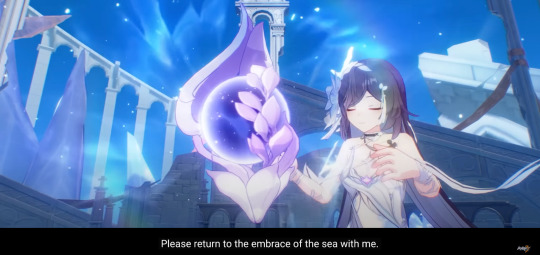
EDIT (9/8/2023): Touched this up a bit and made some grammatical corrections. Thesis is the same, some added support and re-phrasing was done to better convey it.
Sources
A General Introduction to Psychoanalysis by Sigmund Freud
#genshin impact#genshin lore#genshin impact lore#genshin theory#genshin meta#genshin impact meta#fontaine lore#rhinedottir#theory#elynas#durin#melusine#long post
264 notes
·
View notes
Text
“Similar innuendos—originally devised as a marketing ploy, perhaps—would eventually become part of the larger theme of redemption and love. As one critic observed: “As the series progressed, the sly jokes and innuendo turned into loving glances and a physical closeness that was increasingly intimate in nature, beyond the kinds of interactions one sees between ‘just friends’”
Yes, well, you can thank Lucy and Renee for that because they realized themselves that the “wink wink nudge nudge” approach wasn’t WLW representation and they sought to put that right by lessening all of that and instead focused more so on the deep friendship and a relationship that was beyond words and beyond what was subtext. That said so much more. They’re the ones that wanted to make their relationship a larger part of what the show was all about. Not Liz Friedman.
And they could do it because they had the authority to. Which makes a huge difference compared to TV shows today where the actors don’t have any authority at all.
You want to be thanking straight white men and women for the epic love story ‘Xena: Warrior Princess’ became because they’re the ones that knew what to do with it.
I’m not saying Liz Friedman wasn’t on board with all of that. She was. But she was not who “initiated” all of it. She wasn’t the catalyst and she wasn’t the enforcer.
It’s Lucy, Renee, Steven and R.J. that were. These are the people that wanted to make something out of Xena and Gabrielle’s loving relationship beyond “wink wink nudge nudge”. Beyond simple subtext. That made what they had between them the narrative of the entire show and gave it more of a ‘redemptive love’ kind of storyline so Xena was effectively the feminine version of Jesus.
All of this “Transcendent Love” is because of them.
And obviously Rob Tapert who approved this change. Who agreed with wanting to make the Xena and Gabrielle relationship more than cheesy pandering. The whole show could have been just that. Just “wink wink nudge nudge” and “were they/weren’t they” the whole way through. But I can tell you one thing,… if it was, I wouldn’t be saying all this now. I’d have discarded and dumped it in the trash along with all the rest years ago.
I wouldn’t be sat here defending the creators and explaining why it wasn’t queer-baiting right now.
I wouldn’t be anywhere near as passionate as I am. I would have put it in the same category as ‘Supergirl’ or ‘ONCE’ or ‘Rizzoli and Isles’ and said it’s not worth it because it will never follow through on the love story.
I’m not because that’s not the truth and Lucy, Renee, Steven, R.J. and Rob the ones who made sure of it. You can’t watch half of the episodes in this show without realizing that they were absolutely 100% serious with it. No, they couldn’t confirm them explicitly in text. They couldn’t show them kissing or having sex. They couldn’t make it official. It doesn’t even matter about any of that because they intended it to be interpreted as romance.
They were on the side of the X&G fans and the shippers regardless of what they couldn’t actually do or show.
And that is what makes all of the difference. Always.
Getting around forced censorship
VS
intentionally exploitative queer-baiting
So yeah, they needed symbolism, they needed metaphors, they needed poor excuses for them to kiss.
They needed all of that because that was THE ONLY WAY they could actually represent anything properly.
And as I’ve said countless times already … a kiss via water transfer to reinvigorate the protagonist is far more romantically charged than a kiss just to be a kiss.
It’s much more thematically powerful and beautiful. If that’s what it took for them to get a kiss by the censors, then I was perfectly happy with that choice. It was fine. It doesn’t take away from or negate the love between them. Not at all. That actually sounds exactly right for Xena and Gabrielle where love was all about sacrifice.
You see when you look at the context of something - especially historical context - then things aren’t as bad as you think they are because this was how it had to be.
Then go watch an episode of ‘Supergirl’, ‘ONCE’ or ‘Rizzoli and Isles’ and tell me that you can say the same.
Or like any TV show with two lead female protagonists that aren’t immediately canonized as a romantic ship.
Tell me that you can say the same. You can’t. And the reason why you can’t was because it was a different time and place. Censorship wasn’t an issue anymore.
And guess who you have to thank for that being true.
XENA! The entire creators/cast/crew of XENA because they refused to back down on what they really wanted and I will sit on social media and defend them always.
I will not let anybody refer to Xena as “queer-baiting”. There’s plenty of TV shows that deserve that stamp.
Xena isn’t one of them.
#xena warrior princess#xena and gabrielle#xena#lucy lawless#gabrielle#renee o'connor#wlw representation#queer representation
15 notes
·
View notes
Note
I feel that Rolin and co made the right decision in making the vamps a little more human. Also I think for a wider audience, there’s something a little tricky about removing sex from characters, especially considering the amount of sexual assault in the VC?There’s definitely something tragic about Lestat’s turning and then him essentially losing the ability (ish?) to ever have sex again. Nvm Armand’s backstory. I think that’s an interesting thing to explore in the books but I can definitely see how it could come across as alienating for a modern TV fandom and viewing experience.
Yeah, I completely agree both that Rolin and co made the right choice in keeping the vampires a little more human and with bringing sex into it, anon. I think especially with AMC's intention of this being a long running series, keeping sex off the table limits the scope of both experience and theme, especially with sexual assault being such an enormous part of the book series. It really would've run the risk of treating sex as something ultimately harmful that has to be transcended through abstinence, and I think especially would become a part of a broader conversations around censorship in and of queer media.
The removal of queer sexuality and intimacy from TV is a long standing issue after all - like, God, very different genre, obviously, but Mitch and Cam didn't even kiss the entire first season of Modern Family - and for IWTV to have kept sexuality limited to metaphor would I think be perpetuating the trend. Storytelling, after all, doesn't exist in a vacuum, and it should be important to look at it within the context of narrative landscapes.
#i also think you'd come to the issue narratively that not being able to get it up doesn't mean you still can't receive sex#so what does that mean in terms of narrative relationships and especially vampiric relationships to humans who can presumably#still have sex with them?#does that make sense?#i'm getting ready to head out so i hope so haha#iwtv asks
7 notes
·
View notes
Text
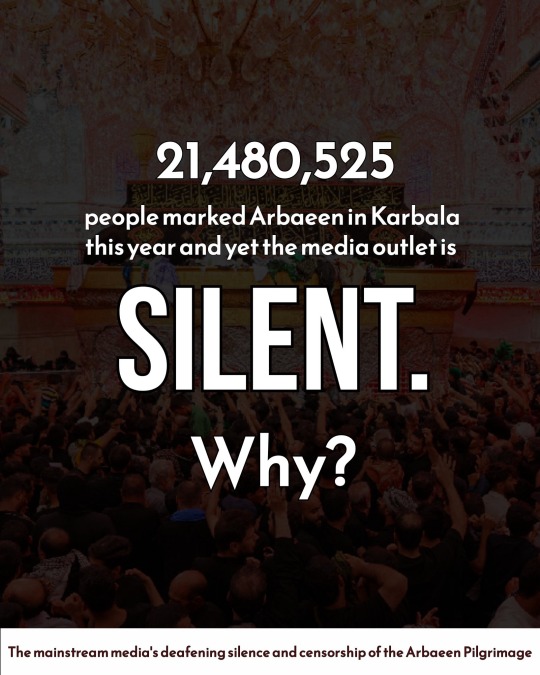
21,480,525 people marked Arbaeen in Karbala and yet the mainstream media is silent. Why?
Understanding the media's deafening silence and censorship of the Arbaeen Pilgrimage.
Typically, one of the primary factors that captures media attention is the scale of participation in public events. The larger the crowd, the greater the news coverage. But this principle seems to vanish when it comes to the annual Arbaeen pilgrimage - arguably the world’s largest peaceful gathering, with over 20 million participants.
If today's world comes to know the wonders of Arbaeen and its impacts, then you will see the people entering Islam in throngs, embracing the Shia School of Thought.
وَرَأَيۡتَ ٱلنَّاسَ يَدۡخُلُونَ فِي دِينِ ٱللَّهِ أَفۡوَاجࣰا
'And you see the people entering into the religion of Allah in multitudes'
[Surah Nasr - verse 2]
This might be one of the reasons why news about Arbaeen is so conspicuously censored.
Consider the contrast:
when protests or demonstrations involving a mere few hundred or thousand of people occur in global cities, news outlets are quick to provide extensive coverage. Reporters and journalists rush to cover events as varied as animal conservation efforts or minor local demonstrations.
Yet, when millions of pilgrims from across different faiths and nationalities converge for Arbaeen in Karbala, to commemorate the martyrdom of an infallible Imam (AS) and to reflect on his principles of justice, sacrifice, and coexistence, the mainstream media is eerily absent.
Why is it that a small protest in London or Paris makes headlines, but the world’s largest human gathering - where women, men, and children walk peacefully together - is largely ignored?
Arbaeen is more than just a religious pilgrimage. It’s a great spiritual journey, a form of jihad (struggle), and a powerful social movement centered around the legacy of an infallible Imam. There is a complete, divinely guided human figure at the core of this gathering. This unparalleled historical phenomenon is precisely why the news surrounding Arbaeen is often suppressed, especially in Western media.
In today’s world, dominated by consumerism and Western secularism, there is a growing crisis of spirituality and justice. As more people from diverse cultures and faiths seek balance and meaning in their lives, many are turning to Islam. This trend is causing increasing concern among non-Muslim governments, particularly in the West, where Islamophobic campaigns attempt to paint the entire Muslim community with the brush of extremism.
These same campaigns tend to spotlight radical ideologies, such as those of takfiri groups - movements often funded and fuelled by Western interests - and use them to generalise and distort the image of Islam as a whole.
In this context, Arbaeen emerges as a powerful counter-narrative. It showcases the true values of Islam: peace, sacrifice, justice, and co-existence. The millions who walk side by side during Arbaeen reflect the very opposite of the divisive images propagated by Islamophobia, demonstrating a message of unity and shared humanity that transcends all boundaries.
#arbaeen#make this blow up#make this go viral#mustshare#sharethis#must watch#ahlulbait#ahlulbayt#muharram#muharam#prophet muhammad#karbala#imam hussain#ali ibn abi talib#islampost#islamdaily#welcome to islam#like and/or reblog!#pls reblog#share this post#share if you can#pls share#like cmon#dontmissout#very interesting#very informative
7 notes
·
View notes
Note
Greetings and hail!
...so this is Hercynia. It's a lot prettier here than the stories of the Crisis that I've been told make it out to be, but I suppose corporate censorship has its upsides if it allowed you enough peace and quiet to rebuild and flourish like this.
Ah, shit, where are my manners - this is callsign Angel speaking, please forgive my rudeness. For legal reasons I should probably disclose that I'm a member of MSMC 796th detachment "Heaven's Fury", but I'm not here on any business. Quite the opposite, actually - I needed some time away from those HA bootlickers idiots, and what better way to spite them than by heading here for a spell.
I'll admit I'm not as educated as I'd like to be on Hercynian history - I grew up on Pyxis (one of Carina's moons; it's a ways from here, and IPS-N folks don't talk much about you), and I completely understand why y'all might be reticent to remind the galaxy that you still exist, especially after what HA did to y'all. (I apologize for continually bringing it up - I'm not really sure how to talk about it tactfully, or if that's even possible.)
I guess what I'm asking here is, well... tell me about Hercynia. What is used to be pre-Crisis, what it is now, what you hope it will become in the future. Something more than the same old horror story that I keep hearing from my coworkers and corporate propaganda. (If I'm allowed to know, that is - I completely understand if that's not the case and I'm overstepping boundaries.)
Yours among the stars,
MC Phoenix “Angel” Michaelis-Landers, MSMC-796-3
What Hercynia was before first contact is still an open question: what we know is what we have gleamed by old artifact and osteomemetics stashed in the deepest recesses of the earth, and every so foten new ones are discovered which futher call into question what we thought. Even what little we have learned paints a fascinating picture: the Egregorians of old did not conceive of themselves as we do; to them there was no rigid distinction between person and non-person, between "civilization" and "nature". Overminds like Endeavor were not their chiefs, but "spiritual" leaders whose guidance transcended factional distinctions. I put "spiritual" in quotes because no sources from that time describe religious beliefs like any seen today or in any other part of the known galaxy; it is unclear if they would have even understood the concept of "worship". I'm not going to touch on what contemporary Hercynians of either species think of that in relation to our current modality of existence: it is a hotly debated topic; but I'd like to reassure you and anyone else reading that it is precisely that: a debate.
As for now... well, it's a strange new world: we went from being alone and tightly held together by pur collective fight, to suddendly not needing to fear for our lives but also needing to contend with knowing and being known by the rest of humanity.
For some, this is the best time to be alive, for others this new contact feels like a sort of cultural agoraphobia, but either way, we're all anchoring ourselves by finding a way to contribute to rebuilding now that we are finally able to.
Some, like me and my colleagues at HRA, are most concerned with finding a way for our people to prosper from the newly opened contact with the rest of civilization, and work tirelessly to find an opportunity to prosper in anythign we have.
Some yet are taking to the stars, out of wonderlust, curiosity, or in a few cases because they've been fighting so long they just don't feel at home doing anything else, and so decided that they might as well help their famileis and friends by sending back their earnings as mercenaries.
In conclusion, this is as bittersweet a time to live on Hercynia as there has ever been a time to live anywhere. We did it, after all, in spite of all the people that didn't. Despite the many difficulties and tribulation still ahead of us, it's hard to be sad.
#lancer rpg#lancerrpg#lancer ttrpg#lancer#no room for a wallflower#egregorians#asks#ask#hercynian refurbished armaments
8 notes
·
View notes
Text
Best Practices to Transcend Censorship on LinkedIn and Twitter Today
Let’s Ask AI about social media and censorship… Maybe some of us left standing can collaborate with LinkedIn learning to ensure compliance with First Amendment of the Constitution of these United State of America. Connections in other countries might be re-inspired by Freedom of Speech in America 1. Censorship is the act of suppressing information or ideas that are considered objectionable or…

View On WordPress
#StateFarmFiles#TwitterFiles#1. Censorship 2. Shadowbanning 3. Virtual book burning 4. Freedom of expression 5. Freedom of speech 6. Human rights 7. Internet freedom 8.#BACK UP#BLOG#BUILDING EMAIL LISTS AND TELTEXT LISTS#DOWNLOAD#Transcend Censorship#USA legal world ethics crisis – NOT ONE DEFENSE COUNSEL OPPOSED FIRST AMENDMENT ATTACK!#VIDEO23#WE ARE THE MEDIA NOW
0 notes
Note
Theory on World Dynamic & Blot Pt. 1 (No Beta, apologies in advance for any and all confusion you may have when reading this. Please delete this is you don't feel comfortable with this):
One of the things I didn't get at first was why the Seven were considered role-models in TWST---I couldn't pinpoint how society would openly idolize people for actions that are openly admitted as wrong in a unanimous sense yet not have someone openly question/challenge this. The Seven are historical figures. Some of the dialogue we do get hints at imperfection that are more close to D!Villains the audience is more familiar with. Assuming Earth is meant to be referring to our Earth (in which it is taken in it's entirety without altercations), I think TWST is meant to have similar core parts that reflect our real-world. History-context-wise, it would make more sense that royal/governing figures(Queen of Hearts, Scar, & Jafar) would be recorded---even considered an example to TWST's present day royalty/governing system on do's and don'ts---and respected as seen by the description on the statues (being able to govern over (what I will assume is) a massive population and having the nation surviving---even thriving---are (objectively) ideal feats to be remembered by and put as positive example in the grand scheme of things). If this is true, then it would also make sense for the Seven to coexist with their respective protagonist(s), making RSA possible but also making the dynamic not as black-and-white as simplification will allow. . .Yana didn't need to write an explanation w/worldbuilding cuz she played it smart and just used what she already had---existing reference called real life.
(Note: I know that this ask opens with “part 1”, but I never received any part 2s or other follow-ups after that DX)
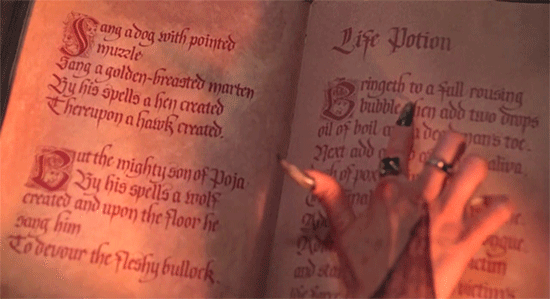
I think I get what you’re trying to communicate? (Correct me if I’m wrong!) So I believe this Anon is saying that 1) both the Disney villains and heroes exist in Twisted Wonderland as historical figures, 2) the alternate tellings of their histories can coexist, and 3) like in real life, history can be twisted depending on the narrative/teller and, in hindsight, actions that are considered dubious can be viewed by future generations as morally correct or righteous. (If that’s the case, I expressed similar thoughts in this post.)
There instances in which the original stories they come from diverge or coexist with other versions which are also treated as true. For example, Kalim tells a tale about a princess (Jasmine) who happily married a thief (Aladdin), transcending the social norms of their time. There is also another tale that the Sorcerer of the Sands (Jafar) revealed that someone (Aladdin) had deceived a princess (Jasmine) about their social status, and that he saved the kingdom by revealing the lie. Somehow, the original story became multiple stories, all of which stand on their own.
We must recall that there are often positive spins put on the tales we know of to be the truth; suddenly Jafar is no longer plotting to overthrow the Sultan, but is a loyal advisor who dutifully served his country, Ursula’s deals are justified because the fault lied with her clients for not paying up, etc. This is also true of real life, where, depending on the person you ask or the history textbook you reference, certain events and details may be glossed over or even completely rewritten. This may be due to censorship or a deliberate attempt to control the narrative and what information is taught to and carried over to students (and into the future). Lilia even makes a passing comment about this in episode 7, saying that history can be “changed” over time.
This is likely how and why the Great Seven are worshipped as they are; history has been “twisted” from the (presumably what Yuu views in their dreams), which just goes to show that good is closer to evil (and vice versa) than expected, thus blurring the lines between the two and creating a grey area. This is very much in line with TWST’s philosophy—that there is more to something than meets the eye, and that being truly “evil” or truly “good” doesn’t exist.
#Lilia Vanrouge#twst#twisted wonderland#disney twisted wonderland#twisted wonderland theory#twisted wonderland theories#twst theories#notes from the writing raven#twst theory
95 notes
·
View notes
Text
Why Bitcoin Over Others?

In a world where thousands of cryptocurrencies seem to appear overnight, it’s easy to lump them all together and label them “just another digital coin.” But doing so misses a crucial point: not all digital assets are created equal. Bitcoin, the original cryptocurrency, stands distinctly apart from the rest. Its history, security, decentralization, and unwavering principles set it on a pedestal far above the flood of imitators. Today, we’ll explore what makes Bitcoin so special—and why it remains the cornerstone of the entire crypto movement.
1. Immaculate Conception and Fair Launch Bitcoin emerged during the aftermath of the 2008 financial crisis, introduced by an unknown individual or group under the pseudonym Satoshi Nakamoto. Unlike many cryptocurrencies that began with pre-mines, venture capital backing, or a charismatic founder front and center, Bitcoin was offered to the world at large with no special advantages for early insiders. Its code was released as open-source software, and anyone could join, mine, and participate. This clean, decentralized birth means there’s no central authority pulling the strings—just a global, diverse community contributing to its growth.
2. Proven Security and Longevity One of the greatest strengths of Bitcoin is its track record. For over a decade, it has operated without needing to “restart” or rewrite its ledger, all while withstanding countless hacking attempts and periods of extreme volatility. Its security model, powered by a vast network of miners performing billions of computational operations per second, has made it incredibly resistant to attacks. This longevity and resilience place Bitcoin in a unique category—no other digital asset has maintained such unshakeable network security for so long.
3. True Decentralization Decentralization is a buzzword often tossed around, but few truly deliver. Bitcoin’s network is spread across the entire globe, with miners, node operators, and developers from all walks of life. No government, company, or consortium controls the network; transactions require no permission and no central gatekeeper. Other cryptocurrencies frequently rely on small teams, foundation boards, or single points of failure. Bitcoin’s decentralized architecture ensures it remains censorship-resistant, neutral, and truly belongs to everyone and no one.
4. Predictable Monetary Policy At the heart of Bitcoin’s monetary policy is a simple but powerful principle: scarcity. There will never be more than 21 million bitcoins, a limit enforced by Bitcoin’s code. This fixed supply contrasts sharply with fiat currencies, which central banks can inflate at will, and with many cryptocurrencies that tweak their monetary policy mid-flight. The reliability of Bitcoin’s halving cycles—where the reward for mining new coins is cut in half roughly every four years—imposes discipline and predictability. This scarcity and transparency help position Bitcoin as “digital gold,” a store of value that transcends borders and politics.
5. Network Effects and Brand Recognition Bitcoin’s first-mover advantage has allowed it to capture the imagination of individuals, institutions, and even some governments. Over time, it has built an unparalleled brand, becoming shorthand for the very concept of digital money. As a result, infrastructure—from exchanges and custodial services to payment processors and lending platforms—has matured around Bitcoin first. Its network effects are self-reinforcing: the more people use and trust Bitcoin, the more robust and valuable it becomes, further attracting new users.
6. Conservative Upgrades and Steady Evolution Unlike many projects that chase trends, implement flashy features prematurely, or pivot narratives every few months, Bitcoin evolves slowly and deliberately. Changes to the Bitcoin protocol undergo intense scrutiny and thorough debate before being adopted. This conservative approach preserves the network’s stability and reliability. Instead of overhauling the system haphazardly, Bitcoin relies on Layer 2 solutions like the Lightning Network to improve efficiency and speed without compromising core principles.
7. A Cultural and Philosophical Touchstone Beyond technology, Bitcoin represents an idea—a rejection of the status quo of endless money printing, centralized oversight, and financial exclusion. It’s a rallying point for those who value privacy, autonomy, sound money, and freedom from the arbitrary decisions of central authorities. This cultural and philosophical dimension is something many altcoins lack. While others may attempt to graft meaning onto their projects, Bitcoin naturally embodies these principles through its origin story, infrastructure, and committed global community.
Conclusion: The Gold Standard of Digital Assets As the cryptocurrency landscape continues to expand, it’s crucial to separate substance from hype. While plenty of coins promise faster transactions, flashy features, or quick gains, few can claim the foundation of trust, resilience, and true decentralization that Bitcoin offers. Bitcoin isn’t just another coin; it’s the benchmark by which all other digital assets are measured.
In choosing Bitcoin over others, you aren’t merely picking a cryptocurrency—you’re aligning yourself with a robust, time-tested network built on transparency, fairness, and sound monetary principles. Amidst an ever-growing sea of digital assets, Bitcoin remains the unwavering beacon lighting the way toward financial sovereignty.
Take Action Towards Financial Independence
If this article has sparked your interest in the transformative potential of Bitcoin, there's so much more to explore! Dive deeper into the world of financial independence and revolutionize your understanding of money by following my blog and subscribing to my YouTube channel.
🌐 Blog: Unplugged Financial Blog Stay updated with insightful articles, detailed analyses, and practical advice on navigating the evolving financial landscape. Learn about the history of money, the flaws in our current financial systems, and how Bitcoin can offer a path to a more secure and independent financial future.
📺 YouTube Channel: Unplugged Financial Subscribe to our YouTube channel for engaging video content that breaks down complex financial topics into easy-to-understand segments. From in-depth discussions on monetary policies to the latest trends in cryptocurrency, our videos will equip you with the knowledge you need to make informed financial decisions.
👍 Like, subscribe, and hit the notification bell to stay updated with our latest content. Whether you're a seasoned investor, a curious newcomer, or someone concerned about the future of your financial health, our community is here to support you on your journey to financial independence.
Support the Cause
If you enjoyed what you read and believe in the mission of spreading awareness about Bitcoin, I would greatly appreciate your support. Every little bit helps keep the content going and allows me to continue educating others about the future of finance.
Donate Bitcoin: bc1qpn98s4gtlvy686jne0sr8ccvfaxz646kk2tl8lu38zz4dvyyvflqgddylk
#Bitcoin#Cryptocurrency#DigitalGold#CryptoEducation#BitcoinOverAltcoins#CryptoCommunity#FinancialFreedom#Decentralization#BlockchainTechnology#SoundMoney#CryptoRevolution#Altcoins#BitcoinStandard#HODL#FutureOfFinance#DigitalCurrency#BitcoinAdvocate#CryptoBlog#WhyBitcoin#BitcoinVsAltcoins#financial empowerment#globaleconomy#unplugged financial#blockchain#financial education#finance#financial experts
4 notes
·
View notes
Note
hi! i've seen you post about it a lot, could you explain nerdy girl overdose? something about anime girl doing drugs is appealing and i feel like you can explain it better than a wikipedia article
Uhm hi!!! needy girl overdose is a management game. you play as the faceless boyfriend of ame, who wants to be a streamer. the gameplay is basically deciding what activities ame should do. she has a new idea for a stream, she could really grow her view count with it. or how about a date night, shes really stressed and could use some time with you. how about the hospital? shes been falling into a dark place lately and might hurt herself. you have to balance these things and see where it takes you. theres so many endings possible that can be 30 minutes or like 2+hrs(?) each, lots of replayability
One big appeal is the overall loveletter to the internet that the game is. the localization is spot on and full of references and jokes and subcultures that is very hard to capture if you havent been around through them (very early one youll see is a RANDY YOUR STICKS reference). it goes into the parasocial relationship the develops in online spaces, having an identity or persona that seen by others. wanting to be seen and loved, how your persona can grow, and these interactions can turn toxic if left unmanaged
Another part of the game is that its very deep into the menhera subculture. its got a lot of emphasis on mental health and dealing with mental issues. ame gets depressed, or goes manic, or abuses her medication, or SH's. theres some. really really good letters she has on some of these things.
The game can get dark, not because it tries to, but just because these things are so intertwined and connected that you kind of have to have it, if you want to be as genuine as you can be. theres not really a central Point to the game, its mostly just. a loveletter to the internet, for all its goods and bads. from the sense of community and belonging that transcends physical bounds, to the destruction and toxity and abuse it can enable for the self and others, the game kind of embraces it all
Switch version has some censorship (drugs are macarons now lol, idk what other changes there are) but its there if you want accessibility to play it, its on steam too, if you're interested, id say pls check it out if you're up for it :3
this should go without saying but this game is not meant to enable self harm or abuse. as i understand, menhera is not so much about getting worse, but using imagery of dark themes with a cuter look as a way of helping to get out of bad habits. like using poison as an antidote, and thats what this game does for me a lot. the darker art and themes helps me vent in a way and holds me off from doing things. take care of yourself! be kind to yourself! dont be mean to your body. its doing the best it can.
29 notes
·
View notes
Text
Exploring the Symbolism of the Anonymous Face: The New "Anonymous Face CyberProcessor" Vector Design
The face of Anonymous, with its iconic Guy Fawkes mask, has become a global symbol of resistance and anonymity. Originating from the film V for Vendetta and later adopted by the hacktivist collective Anonymous, this symbol represents a challenge to authority and a demand for transparency. As a powerful emblem of rebellion, it continues to inspire and provoke. In this article, we’ll delve into the symbolism behind the Anonymous face and introduce the "Anonymous Face CyberProcessor" Vector Design, a modern take on this iconic image.
Understanding the Anonymous Face Symbolism
The Guy Fawkes mask, originally worn by the English revolutionary Guy Fawkes, has transcended its historical context to become a symbol of defiance and anonymity. The mask’s white face, with its stylized mustache and enigmatic smile, represents a resistance to oppressive systems and a desire for personal freedom. Adopted by the hacktivist group Anonymous, the mask has come to signify a collective fight against censorship and control, embodying the spirit of online activism and civil liberties.
Introducing the "Anonymous Face CyberProcessor" Vector Design
Our "Anonymous Face CyberProcessor" Vector Design offers a contemporary reinterpretation of this iconic symbol. Combining the familiar elements of the Guy Fawkes mask with a sleek, cyber-inspired aesthetic, this design breathes new life into the classic image. Here’s why this vector pack is an essential addition to your creative toolkit:
Features of the Design:
Contemporary Cyber Twist: The design modernizes the traditional Anonymous face by integrating futuristic and cyber elements. This fresh approach adds a dynamic, high-tech flair to the well-known symbol.
High-Quality File Formats: The vector pack includes SVG, AI, EPS, PNG, JPEG, and PDF files, all optimized for various design applications. This ensures you can seamlessly incorporate the design into any project, from digital graphics to physical merchandise.
Versatile Uses: Ideal for a broad range of applications, including t-shirts, wall art, mugs, stickers, and banners. The design’s adaptability makes it suitable for personal projects, commercial products, and promotional materials.
Commercial Rights Included: With your purchase, you receive a license to create and sell derivative works, providing you with the freedom to use the design in your commercial endeavors.
Usage Guidelines: Redistribution of the original files or unchanged graphics is not allowed. Keep your payment receipt as proof of your commercial use rights.
Applications and Benefits
The "Anonymous Face CyberProcessor" Vector Design is perfect for those looking to add a modern, edgy touch to their designs. Whether you’re creating custom apparel, eye-catching posters, or unique decor items, this vector design offers versatility and style. Its updated look ensures that your projects stand out while still honoring the powerful symbolism of the Anonymous face.
The Anonymous face remains a compelling symbol of resistance and anonymity. Our "Anonymous Face CyberProcessor" Vector Design revitalizes this iconic image with a contemporary cyber twist, making it an excellent choice for diverse creative projects. Embrace the power of this modern design to enhance your work and make a bold statement.
Get your vector pack today and start integrating this modernized symbol into your designs!
#AnonymousFaceDesign#AnonymousMaskArt#AnonymousIcon#AnonymousGraphics#AnonymousFaceVector#AnonymousFace#CyberProcessorDesign#VectorGraphics#GuyFawkesMask#ModernDesign#IconicSymbols#CreativeVectorArt#CommercialDesigns#DigitalArtwork#FuturisticGraphics
2 notes
·
View notes
Note
hi! i just found this if and I'm just wondering what does muhyeop and murim mean?
sure! this is about to get long (lol) but i'll try to do it as clearly as i can. as succinctly as possible, muhyeop is a historical korean fantasy genre featuring martial artists, and murim refers to the martial arts society/world within the story. some people like to use the terms interchangeably.
muhyeop is considered an offshoot of a genre that was popularized in china (that's why the story is set in china!) and is heavily influenced by authors like wolong sheng and gu long. you might've heard of terms like wuxia (lit, martial heroes) which focuses on the adventures of martial artists and xianxia (immortal heroes) a more fantastical take on the genre that includes principles from philosophies, customs, and religions like taoism, buddhism, and traditional practices. muhyeop is in the same family as those genres.
it's very, very popular and there's an interesting history behind it. some scholars argue the genre served as a mouthpiece when direct political protest was banned (which led to censorship of published books in korean and taiwan). they have a little historical basis to them, but it's a broad term. like how "fantasy" as a genre in the western world can mean anything from modern-day star power warriors to Ye Olde Knights Slaying Dragons.
a lot of common tropes include examples of immortality achieved through personal cultivation and/or martial might, good vs evil, chivalry, sword fighting (duh), and transcendence of mortality. there are four main generations of the muhyeop genre (a first-gen muhyeop author founded one of the largest webnovel publishing sites in korea!) and each gen expanded on set tropes and established new ideas/principles.
murim or wulin refers to the martial arts society that appears in muhyeop stories and is based on the actual martial arts society that was believed to have existed during the dynasties. the clans and families that are featured in the story also have historical significance, but ofc since people weren't actually using internal fantasy powers to achieve feats like immortality and super-strength, they just co-exist with their irl counterparts.
if this is your introduction to it i'm super happy to have explained it a little, and i hope it sparked your interest! there are thousands of incredible series and media out there, and i hope you check some of them out!
#anon#what do i tag this as#world building#let's go with world building#if you want to talk about it more#i can go allllllll day#(ignore the spelling mistakes i typed this on my phone)
18 notes
·
View notes
Text
The Orwellian Nightmare: How Modern Media Contributes to the New World Order**
George Orwell's works, particularly "1984" and "Animal Farm," have become almost prophetic in describing the potential dangers of unchecked governmental power and the erasure of individual freedoms. Today, his cautionary tales resonate more than ever as the convergence of media, technology, and governance increasingly resembles the dystopian visions he warned us about. The pervasive influence of contemporary media may not just mirror Orwell's warnings but exacerbate a push towards a one-world totalitarian government.
In "Animal Farm," Orwell illustrates how propaganda can manipulate and control a population. The pigs on the farm, who gradually assume totalitarian control, use constant propaganda to justify their actions and maintain power. In the current era, traditional media and social platforms have a similar power. News outlets often present information in a manner designed to generate specific emotional responses, leading to polarized populations that are more easily manipulated.
The line between news and propaganda has blurred, making it challenging for individuals to discern objective truths from manipulative narratives. The omnipresent nature of media ensures that particular ideologies reach mass audiences swiftly, influencing public opinion and shaping societal norms. When critical analysis is replaced with echo chambers and bias confirmation, societies drift closer to the totalitarian control described in Orwell’s works.
Orwell's "1984" introduces us to Big Brother, the omnipresent surveillance state that monitors every facet of individual life. Today, tech giants like Google, Facebook, and Amazon collect vast amounts of data on every user. While marketed as tools for convenience and connectivity, these technologies also enable unprecedented levels of surveillance.
Every click, search, and location is logged, creating detailed profiles that can be used for targeted advertising, but also potentially for social control. Governments can and do access these troves of data, ostensibly for national security purposes. The merging of government oversight with corporate data collection creates a surveillance state far more sophisticated and intrusive than Orwell could have anticipated. This relentless monitoring facilitates control over populations, ensuring compliance and limiting dissent.
In Orwell's dystopian world, the past is constantly rewritten to serve the present narrative. This manipulation of history is complemented by stringent censorship. Today, the control of information is often more subtle but no less effective. Algorithms on social media platforms can suppress or promote content, subtly shaping what information is seen and what is hidden. Governments and corporations can collaborate to remove or censor undesirable information, often under the guise of combatting "fake news" or protecting public safety.
Moreover, the rise of "cancel culture" acts as a societal enforcement mechanism, where individuals are ostracized and silenced for expressing contrarian views. This peer-enforced censorship ensures that only a narrow range of acceptable opinions is publicly shared, pushing societies towards homogenized thought and Orwellian conformity.
Orwell’s warnings about power coalescing into an omnipotent state resonate with contemporary movements toward global governance. Organizations like the United Nations and the World Economic Forum are increasingly influential in shaping international policy, transcending national sovereignty. While global cooperation can address transnational issues like climate change and pandemics, it also risks concentrating power in unaccountable bureaucratic entities.
When media, technology, and governance intertwine at a global level, the risk of creating a one-world totalitarian government becomes palpable. Centralized control over information, coupled with global surveillance networks, could lead to a scenario where dissent is virtually impossible, echoing the most terrifying aspects of Orwell's dystopias.
Orwell's texts are not just stories but warnings. It is time we recognize and react to the signs of creeping totalitarianism in modern media and governance. The balance between security and freedom, between global cooperation and local autonomy, must be vigilantly maintained. Individuals must demand transparency, accountability, and the protection of individual liberties in the face of ever-expanding state and corporate power.
The Orwellian nightmare need not become our reality, but avoiding it requires awareness, critical thinking, and active resistance to the seductive allure of total control. By understanding the parallels between Orwell’s world and our own, we can strive to safeguard the freedoms that are easily lost but so difficult to reclaim.
#new world order#new world depression#life#free all oppressed peoples#animals#animal farm#george orwell
6 notes
·
View notes